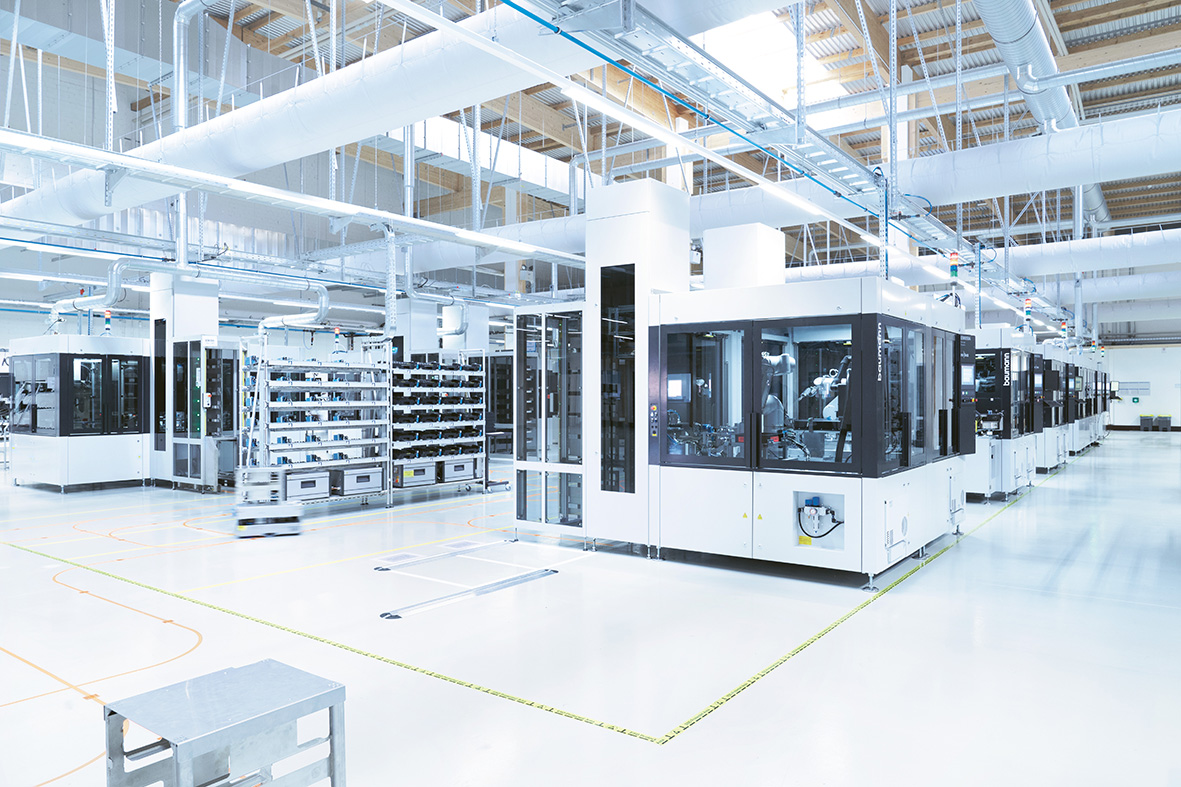
Annual Report
WELCOME TO THE FUTURE
Everybody’s talking about Industry 4.0, the fourth Industrial Revolution that is well under way: The networking and control of machines and processes with the help of information and communication technologies is causing major changes in manufacturing.
While the production of the future is still taking shape, it is already reality at one of SICK’s sites: Instead of rigid lines, twelve fully automated assembly modules, four manual modules, and one hybrid stand like islands in the light and airy hall. The order in which the modules are used in the production process varies according to the requirements. Material is supplied via automated guided carts that drive autonomously along the aisles and interact with humans in a collaborative work environment.

All processes are controlled by high-performance software developed by SICK. All information for the particular order is stored in this so-called multi-agent system, e. g., product properties, unit numbers, and instructions on which production step is necessary on which module. The system sends the information to the machines and constantly receives feedback. All the actors – sensors, machines, and humans – are organized decentralized, networked, and are in continuous exchange with each other. Whereby the system controls many processes completely autonomously.
None of this is experimental. It is a productive factory that already offers SICK decisive advantages in an increasingly dynamic market. “We currently manufacture five product families here, a total of 12 are planned for the future. Production of more than 500,000 product variants is conceivable,” says Joachim Schultis, Head of Operations Photoelectric Sensors & Fibers. “The variances are almost limitless with this type of production. So we can respond to customer wishes – which are becoming more and more varied and individual – extremely well. We even produce small unit numbers ‘on demand’ and still affordably for our customers.” The system also offers a clear advantage regarding new products: “We can implement and launch new developments on the market considerably quicker. The groundwork has been completed and we are now working on further expanding the system.” The high level of flexibility is accompanied by enormous resource efficiency: Orders are prioritized with the help of the software, while the modules and the personnel are optimally employed. Just-in-time production is therefore also possible.

SICK early on recognized the enormous opportunities offered by Industry 4.0 and it now wants to fully exploit them with this production plant. Several years of preparation and large amounts of money have been invested in this major project, with which SICK yet again takes on a pioneering role: “The courage to approach new things as an interdisciplinary team and our strong focus on innovation are precisely what makes SICK special – and has often created a decisive competitive edge for us,” says Joachim Schultis. Thus, SICK has also already paved the way for further development of the site: “We have thought very far ahead. There are plants here for products that we do not even produce yet,” adds Joachim Schultis. There is still space available for more production modules; a second transport line for material is possible at a height of about three meters. The production of more and more products will gradually be introduced here.
SICK has created the ideal prerequisites for growing with and on Industry 4.0: “We gain valuable expertise here every day, enabling us to improve and further expand this type of production,” explains Joachim Schultis. Whereby what matters is not just the processes and procedures in the digitally networked factory, but also the continuous optimization of our own products, solutions, and services as well as their commercial exploitation – because sensors, as data suppliers for the control systems, are ultimately the foundation of every Industry 4.0 scenario. “We only use our sensors and sensor systems in the plants. They must demonstrate here what they can achieve under real conditions. This gives us important knowledge on their overall functioning, shows us where we can still achieve optimizations, and provides the stimulus for new developments.”
This is, therefore, doubly suitable as an effective scenario for achieving ambitious objectives: “We want to position SICK as an expert and premium partner for Industry 4.0. A company that supports its customers comprehensively and competently on their path into the future,” Joachim Schultis sums up. ///

»WE ONLY USE OUR SENSORS AND SENSOR SYSTEMS IN THE PLANTS. THEY MUST DEMONSTRATE HERE WHAT THEY CAN ACHIEVE UNDER REAL CONDITIONS.«
JOACHIM SCHULTIS, HEAD OF OPERATIONS PHOTOELECTRIC SENSORS & FIBERS